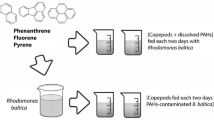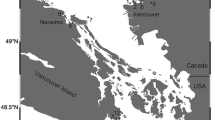Abstract
Experiments were designed to expose blue mussels (Mytilus edulis) to contaminated sediment collected from Narragansett Bay, Rhode Island, USA in 1982. Measurements were taken to allow comparisons of the uptake and depuration of polycyclic aromatic hydrocarbons (PAHs) and polychlorinated biphenyls (PCBs). In addition, concentration factors in the mussels were calculated separately against the dissolved and particulate phase concentrations and the results from the exposure and control systems were compared. Both PAHs and PCBs were rapidly accumulated by the mussels exposed to the contaminated sediment. After the mussels were transferred to control seawater, individual PAHs were depurated with half-lives ranging from 12 to 30 d. Individual PCBs showed depuration half-lives which ranged from 16 to 46 d. Concentration factors in the mussels calculated against the particulate phase concentrations were very different in the exposure and control systems. Concentration factors calculated using only the dissolved phase concentrations (bioconcentration factors) showed excellent agreement in the two systems, possibly an indication that the dissolved phase was the direct source of the contaminants accumulated by the mussels. The bioconcentration factors for PCBs were higher than those of PAHs when compounds with similar n-octanol/water partition coefficients were compared.
Similar content being viewed by others
Literature cited
Afghan, B. K., R. J. Wilkinson, A. Chow, T. W. Findley, H. D. Gesser and K. I. Srikameswaran: A comparative study of the concentration of polynuclear aromatic hydrocarbons by open cell polyurethane foams. Water Res. 18, 9–16 (1984)
Bjorseth, A., J. Knutzen and J. Skei: Determination of polycyclic aromatic hydrocarbons in sediments and mussels from Saudafjord, W. Norway, by glass capillary gas chromatography. Sci. Total Envir. 13, 71–88 (1979)
Chiou, C. T., V. H. Freed, D. W. Schmedding and R. L. Kohnert: Partition coefficient and bioaccumulation of selected organic chemicals. Envir. Sci. Technol. 11, 475–478 (1977)
Chiou, C. T., P. E. Porter and D. W. Schmedding: Partition equilibria of nonionic organic compounds between soil organic matter and water. Envir. Sci. Technol. 17, 227–231 (1983)
Courtney, W. A. M. and G. R. W. Denton: Persistence of polychlorinated biphenyls in the hard clam (Mercenaria mercenaria) and the effect upon the distribution of these pollutants in the estuarine environment. Envir. Pollut. 10, 55–64, (1976)
Cowan, A. A.: Organochlorine compounds in mussels from Scottish coastal waters. Envir. Pollut. (Ser. B) 2, 129–143 (1981)
de Lappe, B. W., R. W. Risebrough and W. Walker II: A largevolume sampling assembly for the determination of synthetic organic and petroleum compounds in the dissolved and particulate phases of seawater. Can. J. Fish. aquat. Sci. 40 (Suppl. 2), 322–336 (1983)
DiToro, D. M. and L. M. Horzempa: Reversible and resistant components of PCB adsorption-desorption: isotherms. Envir. Sci. Technol. 16, 594–602 (1982)
Dunn, B. P. and H. F. Stich: Monitoring procedures for chemical carcinogens in coastal waters. J. Fish. Res. Bd Can. 33, 2040–2046 (1976)
Farrington, J. W., R. W. Risebrough, P. L. Parker, A. C. Davis, B. W. de Lappe, J. K. Winters, D. Boatwright and N. M. Frew: Hydrocarbons, polychlorinated biphenyls, and DDE in mussels and oysters from the U.S. Coast, 1976–1978. The Mussel Watch, 106 pp. Tech. Report 82-42, Woods Hole Oceanographic Institution 1982
Galloway, W. B., J. L. Lake, D. K. Phelps, P. F. Rogerson, V. T. Bowen, J. W. Farrington, E. D. Goldberg, J. L. Laseter, G. C. Lawler, J. H. Martin and R. W. Risebrough. The Mussel Watch: intercomparison of trace level constituent determinations. Envir. Toxicol. Chem. 2, 395–410 (1983)
Gesser, H. D., A. Chow, F. C. Davis, J. F. Uthe and J. Reinke: The extraction and recovery of polychlorinated biphenyls (PCB) using porous polyurethane foam. Anal. Lett. 4, 883–886 (1971)
Geyer, H., P. Sheehan, D. Kotzias, D. Freitag and F. Korte: Prediction of ecotoxicological behavior of chemicals: relationship between physio-chemical properties and bioaccumulation of organic chemicals in the mussel Mytilus edulis. Chemosphere 11, 1121–1134 (1982)
Horzempa, L. M. and D. M. DiToro: The extent of reversibility of polychlorinated biphenyl adsorption. Water Res. 17, 851–859 (1983)
Karickhoff, S. W., D. S. Brown and T. A. Scott: Sorption of hydrophobic pollutants on natural sediments. Water Res. 13, 241–248 (1979)
Kenaga, E. E. and C. A. I. Goring: Relationship between water solubility, soil sorption, octanol-water partitioning, and concentration of chemicals in biota. In: Aquatic toxicology, pp 78–115. Ed. by J. G. Eaton, P. R. Parrish and A. C. Hendricks. Philadelphia: ASTM Press 1980
Knutzen, J. and B. Sortland: Polycyclic aromatic hydrocarbons (PAH) in some algae and invertebrates from moderately polluted parts of the coast of Norway. Water Res. 16, 421–428 (1982)
Lake, J. L., S. Pavignano, C. W. Dimock, C. B. Norwood, P. F. Rogerson, D. K. Phelps, R. D. Bowen and W. B. Galloway: PCBs and other chlorinated organic compounds in sediments, transplanted mussels, and suspended particulate material from a New England estuary. (Unpublished data)
Langston, W. J.: Accumulation of polychlorinated biphenyls in the cockle Cerastoderma edule and the tellin Macoma balthica. Mar. Biol. 45, 265–272 (1978a)
Langston, W. J.: Persistence of polychlorinated biphenyls in marine bivalves. Mar. Biol. 46, 35–40 (1978b)
Lee, R. F., W. S. Gardner, J. W. Anderson, J. W. Blaylock and J. Barwell-Clarke: Fate of polycyclic aromatic hydrocarbons in controlled ecosystem enclosures. Envir. Sci. Technol. 12, 832–838 (1978)
Lowe, J. I., P. R. Parrish, J. M. Patrick, Jr. and J. Forester: Effects of the polychlorinated biphenyl Aroclor 1254 on the American oyster Crassostrea virginica. Mar. Biol. 17, 209–214 (1972)
Mackay, D.: Correlation of bioconcentration factors. Envir. Sci. Technol. 16, 274–278 (1982)
Mackay, D., A. Bobra and W. Y. Shiu: Relationships between aqueous solubility and octanol-water partition coefficients. Chemosphere 9, 701–711 (1980a)
Mackay, D., M. Joy and S. Paterson: A quantitative water, air, sediment interaction (QWASI) fugacity model for describing the fate of chemicals in lakes. Chemosphere 12, 981–997 (1983)
Mackay, D., R. Mascarenhas and W. Y. Shiu: Aqueous solubility of polychlorinated biphenyls. Chemosphere 9, 257–264 (1980b)
Mackie, P. R., R. Hardy, K. J. Whittle, C. Bruce and A. S. McGill: The tissue hydrocarbon burden of mussels from various sites around the Scottish coast. In: Polynuclear aromatic hydrocarbons: chemistry and biological effects. pp 379–393. Ed. by A. Bjorseth and A. J. Dennis. Columbus: Battelle Press 1980
Neely, W. B., D. R. Branson and G. E. Blau: Partition coefficient to measure bioconcentration potential of organic chemicals in fish. Envir. Sci. Technol. 8, 113–115 (1974)
Obana, H., S. Hori, A. Nakamura and T. Kashimoto: Uptake and release of polynuclear aromatic hydrocarbons by short-necked clams (Tapes japonica). Water Res. 17, 1183–1187 (1983)
Oviatt, C. A. and S. W. Nixon: Sediment resuspension and deposition in Narragansett Bay. Estuar. cstl mar. Sci. 3, 201–217 (1975)
Phelps, D. K. and W. B. Galloway: A report on the coastal environmental assessment station (CEAS) program. Rapp. P.-V. Rev Cons. int. Explor. Mer 179, 76–81 (1980)
Pruell, R. J.: The geochemistry of organic contaminants in Narragansett Bay sediments and the availability of these compounds to the blue mussel, Mytilus edulis. Ph.D. dissertation, University of Rhode Island, 250 pp. 1984
Pruell, R. J., J. G. Quinn, J. L. Lake and W. R. Davis: Availability of polychlorinated biphenyls and polycyclic aromatic hydrocarbons to the blue mussel, Mytilus edulis, from artificially resuspended estuarine sediment. In: Ocean processes in marine pollution, vol 1. Ed. by J. M. Capuzzo and D. R. Kester. Melbourne, FL: Krieger Publishing (In press)
Readman, J. W., R. F. C. Mantoura, M. M. Rhead and L. Brown: Aquatic distribution and heterotrophic degradation of polycyclic aromatic hydrocarbons (PAH) in the Tamar Estuary. Estuar. cstl Shelf Sci. 14, 369–389 (1982)
Risebrough, R. W., B. W. de Lappe and T. T. Schmidt: Bioaccumulation factors of chlorinated hydrocarbons between mussels and seawater. Mar. Pollut. Bull. 7, 225–228 (1976)
Roesijadi, G., J. W. Anderson and J. W. Blaylock: Uptake of hydrocarbons from marine sediments contaminated with Prudhoe Bay crude oil: influence of feeding type of test species and availability of polycyclic aromatic hydrocarbons. J. Fish. Res. Bd Can. 35, 608–614 (1978a)
Roesijadi, G., D. L. Woodruff and J. W. Anderson: Bioavailability of naphthalenes from marine sediments artificially contaminated with Prudhoe Bay crude oil. Envir. Pollut. 15, 223–229 (1978b)
Saxena, J., J. Kozuchowski and D. K. Basu: Monitoring of polynuclear aromatic hydrocarbons in water. I. Extraction and recovery of benzo(a)pyrene with porous polyurethane foam. Envir. Sci. Technol. 11, 682–685 (1977)
Schwarzenbach, R. P. and J. Westall: Transport of nonpolar organic compounds from surface water to groundwater. Laboratory sorption studies. Envir. Sci. Technol. 15, 1360–1367 (1981)
Sinnet, J. C. and W. R. Davis: A programmable turbidistat for suspended particles in laboratory aquaria. J. exp. mar. Biol. Ecol. 73, 167–174 (1983)
Snedecor, G. W. and W. G. Cochran: Statistical methods, 593 pp. Ames: Iowa State University Press 1973
Sullivan, K. F., E. L. Atlas and C. Giam: Adsorption of phthalic acid esters from seawater. Envir. Sci. Technol. 16, 428–432 (1982)
Veith, G. D., D. L. DeFoe and B. V. Bergstedt: Measuring and estimating the bioconcentration factor of chemicals in fish. J. Fish. Res. Bd Can. 36, 1040–1048 (1979)
Veith, G. D., K. J. Macek, S. R. Petrocelli and J. Carroll: An evaluation of using partition coefficients and water solubility to estimate bioconcentration factors for organic chemicals in fish. In: Aquatic toxicology, pp 117–129. Ed. by J. G. Eaton, P. R. Parrish and A. C. Hendricks. Philadelphia: ASIM Press 1980
Vreeland, V.: Uptake of chlorobiphenyls by oysters. Envir. Pollut. 6, 135–140 (1974)
Author information
Authors and Affiliations
Additional information
Communicated by J. M. Shick, Orono
Rights and permissions
About this article
Cite this article
Pruell, R.J., Lake, J.L., Davis, W.R. et al. Uptake and depuration of organic contaminants by blue mussels (Mytilus edulis) exposed to environmentally contaminated sediment. Marine Biology 91, 497–507 (1986). https://doi.org/10.1007/BF00392601
Accepted:
Issue Date:
DOI: https://doi.org/10.1007/BF00392601




